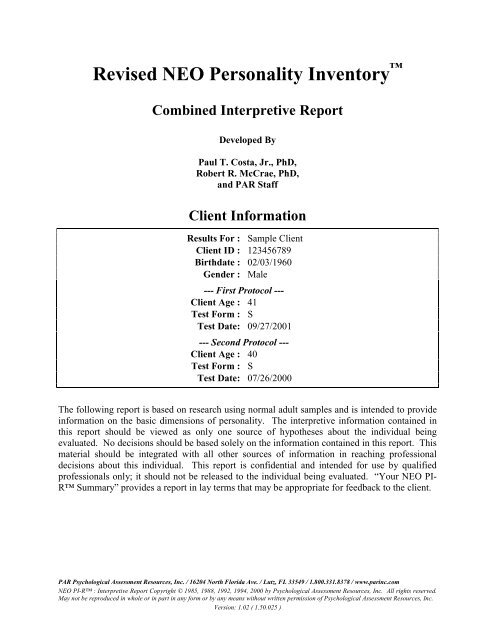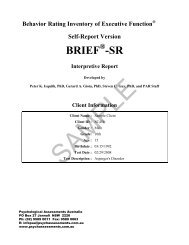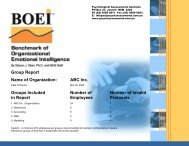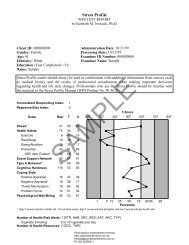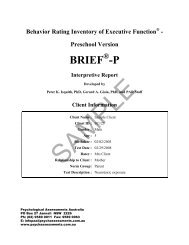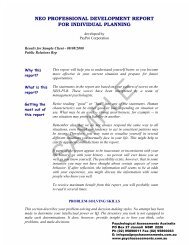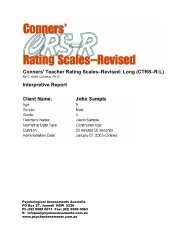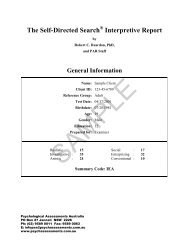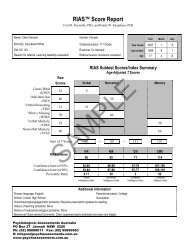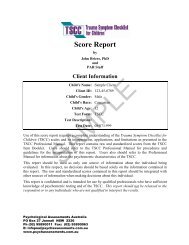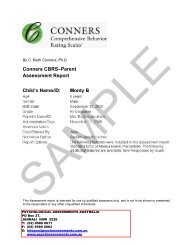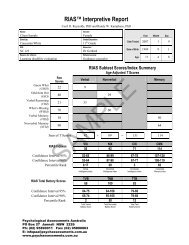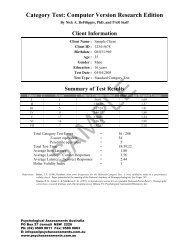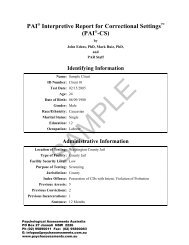Revised NEO Personality Inventory - Psychological Assessments ...
Revised NEO Personality Inventory - Psychological Assessments ...
Revised NEO Personality Inventory - Psychological Assessments ...
- No tags were found...
You also want an ePaper? Increase the reach of your titles
YUMPU automatically turns print PDFs into web optimized ePapers that Google loves.
<strong>Revised</strong> <strong>NEO</strong> <strong>Personality</strong> <strong>Inventory</strong> Combined Interpretive ReportDeveloped ByPaul T. Costa, Jr., PhD,Robert R. McCrae, PhD,and PAR StaffClient InformationResults For : Sample ClientClient ID : 123456789Birthdate : 02/03/1960Gender : Male--- First Protocol ---Client Age : 41Test Form : STest Date: 09/27/2001--- Second Protocol ---Client Age : 40Test Form : STest Date: 07/26/2000The following report is based on research using normal adult samples and is intended to provideinformation on the basic dimensions of personality. The interpretive information contained inthis report should be viewed as only one source of hypotheses about the individual beingevaluated. No decisions should be based solely on the information contained in this report. Thismaterial should be integrated with all other sources of information in reaching professionaldecisions about this individual. This report is confidential and intended for use by qualifiedprofessionals only; it should not be released to the individual being evaluated. “Your <strong>NEO</strong> PI-R Summary” provides a report in lay terms that may be appropriate for feedback to the client.PAR <strong>Psychological</strong> Assessment Resources, Inc. / 16204 North Florida Ave. / Lutz, FL 33549 / 1.800.331.8378 / www.parinc.com<strong>NEO</strong> PI-R : Interpretive Report Copyright © 1985, 1988, 1992, 1994, 2000 by <strong>Psychological</strong> Assessment Resources, Inc. All rights reserved.May not be reproduced in whole or in part in any form or by any means without written permission of <strong>Psychological</strong> Assessment Resources, Inc.Version: 1.02 ( 1.50.025 )
Client: Sample ClientClient ID: 123456789 Page 2 of 19<strong>NEO</strong> PI-R T-Score ProfileT-Score≥ 80T-Score≥ 8070706060505040403030≤ 20<strong>NEO</strong>ACN2 N4 N6 E2 E4 E6 O2 O4 O6 A2 A4 A6 C2 C4 C6N1 N3 N5 E1 E3 E5 O1 O3 O5 A1 A3 A5 C1 C3 C5≤ 20
Client: Sample ClientClient ID: 123456789 Page 3 of 19<strong>NEO</strong> PI-R Combined Data TableScaleSample ClientRaw T RangeScore ScoreSample ClientRaw T RangeScore ScoreMeanT ScoreFactors(N) Neuroticism 60 45 Average 83 54 Average 49(E) Extraversion 109 47 Average 96 43 Low 44(O) Openness 101 48 Average 118 56 High 52(A) Agreeableness 137 62 High 117 53 Average 59(C) Conscientiousness 129 55 Average 122 51 Average 53Neuroticism Facets(N1) Anxiety 9 41 Low 21 66 Very High 54(N2) Angry Hostility 9 43 Low 11 47 Average 44(N3) Depression 10 47 Average 15 57 High 52(N4) Self-Consciousness 12 46 Average 10 41 Low 42(N5) Impulsiveness 11 40 Low 18 56 High 48(N6) Vulnerability 9 49 Average 8 47 Average 48Extraversion Facets(E1) Warmth 24 54 Average 25 57 High 56(E2) Gregariousness 18 54 Average 18 54 Average 55(E3) Assertiveness 17 51 Average 17 51 Average 51(E4) Activity 20 56 High 11 35 Low 45(E5) Excitement-Seeking 8 30 Very Low 9 33 Very Low 29(E6) Positive Emotions 22 56 High 16 42 Low 49Openness Facets(O1) Fantasy 10 35 Low 19 54 Average 44(O2) Aesthetics 22 60 High 25 65 High 64(O3) Feelings 15 38 Low 24 61 High 49(O4) Actions 15 47 Average 10 34 Very Low 39(O5) Ideas 20 50 Average 20 50 Average 50(O6) Values 19 46 Average 20 48 Average 47Agreeableness Facets(A1) Trust 21 50 Average 25 60 High 56(A2) Straightforwardness 28 68 Very High 25 61 High 67(A3) Altruism 24 53 Average 20 42 Low 47(A4) Compliance 24 66 Very High 17 47 Average 58(A5) Modesty 18 50 Average 13 38 Low 43(A6) Tender-Mindedness 22 56 High 17 42 Low 49Conscientiousness Facets(C1) Competence 23 51 Average 23 51 Average 51(C2) Order 19 50 Average 18 48 Average 49(C3) Dutifulness 24 52 Average 22 47 Average 49(C4) Achievement Striving 22 57 High 18 47 Average 52(C5) Self-Discipline 24 55 Average 22 50 Average 53(C6) Deliberation 17 48 Average 19 53 Average 51
Client: Sample ClientClient ID: 123456789 Page 4 of 19Validity IndicesPlease see the individual reports for validity indices.Basis of InterpretationThis report compares this person to other adult men. It is based on self-reports of the individual.Adjusted Mean T-Scores are calculated by a formula designed for combined reports from twodifferent observers. When applied to two tests from the same respondent, they are less accurateand probably exaggerate both high and low scores.The T-Scores reported in this report may differ from the T-Scores of the individual client reportsif they were created using different norms.At the broadest level, personality can be described in terms of five basic dimensions or factors.<strong>NEO</strong> PI-R domain scores provide good estimates of these five factors by summing the six facetsin each domain. Domain scores can be calculated easily by hand and are therefore used on the(hand-scored) Profile Form. More precise estimates of standing on the five factors, however, areprovided by factor scores, which are a weighted combination of scores on all 30 facets (see Table2 in the <strong>NEO</strong> PI-R Professional Manual). Factor scores are best calculated by computer.Because factor scores have somewhat higher convergent and discriminant validity, they are usedas the basis of this report. In general, domain T scores and factor T scores are very similar;occasionally, however, they differ. In these cases, the factor T score, which incorporatesinformation from all 30 facets, is usually a more accurate description of the individual.Factor scores are used to describe the individual at a global level, based on a composite of facetscale scores. To the extent that there is wide scatter among facet scores within a domain,interpretation of that domain and factor becomes more complex. Interpretive statements at thefactor level may occasionally conflict with interpretive statements at the facet level. In thesecases, particular attention should be focused on the facet scales and their interpretations.Overall Profile AgreementThe Coefficient of Profile Agreement, based on the factor scores of the individual and theobserver, is 0.33. This means that the overall agreement on the individual's personality is low incomparison with agreement seen among research volunteer couples.These two profiles show substantial disagreement on the following:ScaleSample ClientRaw T RangeScore ScoreSample ClientRaw T RangeScore ScoreMeanT ScoreNeuroticism Facets(N1) Anxiety 9 41 Low 21 66 Very High 54(N5) Impulsiveness 11 40 Low 18 56 High 48Extraversion Facets(E4) Activity 20 56 High 11 35 Low 45(E6) Positive Emotions 22 56 High 16 42 Low 49Openness Facets(O1) Fantasy 10 35 Low 19 54 Average 44(O3) Feelings 15 38 Low 24 61 High 49
Client: Sample ClientClient ID: 123456789 Page 5 of 19Agreeableness Facets(A3) Altruism 24 53 Average 20 42 Low 47(A4) Compliance 24 66 Very High 17 47 Average 58(A6) Tender-Mindedness 22 56 High 17 42 Low 49Global Description of <strong>Personality</strong>: The Five FactorsThe most distinctive feature of this individual’s personality is his standing on the factor ofAgreeableness. People who score in this range are typically good-natured and treat people withcourtesy and respect. They are sympathetic and tend to be lenient with others. In groupinteractions, they are more likely to cooperate than to compete. They are trusting andstraightforward. People might describe them as helpful and generous.This person is described as being low in Extraversion. Such people are somewhat introverted,preferring to do many things alone or with a small group of people. They avoid large, noisyparties and tend to be quiet and reserved in social interactions. Those who know such peoplewould probably describe them as retiring and serious. The fact that these individuals areintroverted does not necessarily mean that they lack social skills--many introverts function verywell in social situations, although they might prefer to avoid them. Note also that introversiondoes not imply introspection; these individuals are likely to be thoughtful and reflective only ifthey are also high in Openness.Next, consider the individual’s level of Conscientiousness. Men who score in this range have anormal level of need for achievement. They are able to set work aside in pursuit of pleasure orrecreation. They are moderately well organized and fairly reliable, and have an average amountof self-discipline.This person is described as being average in Openness. Average scorers like him value both thenew and the familiar, and have an average degree of sensitivity to inner feelings. They arewilling to consider new ideas on occasion, but they do not seek out novelty for its own sake.Finally, the individual is rated in the average range in Neuroticism. Individuals scoring in thisrange are average in terms of their emotional stability. They experience a normal amount ofpsychological distress and have a typical balance of satisfactions and dissatisfactions with life.They are neither high nor low in self-esteem. Their ability to deal with stress is as good as theaverage person’s.Detailed Interpretation: Facets of N, E, O, A, and CEach of the five factors encompasses a number of more specific traits, or facets. The <strong>NEO</strong> PI-Rmeasures six facets in each of the five factors. An examination of the facet scores provides amore detailed picture of the distinctive way that these factors are seen in this person.NeuroticismThis individual is perceived as being occasionally nervous or apprehensive, but no more so thanthe average individual. He seldom feels frustrated, irritable, and angry at others and he has onlythe occasional periods of unhappiness that most people experience. Embarrassment or shynesswhen dealing with people, especially strangers, is not a problem for him. He is described asbeing average at controlling his impulses and desires and he is able to handle stress as well asmost people.
Client: Sample ClientClient ID: 123456789 Page 6 of 19ExtraversionThis person is rated as being very warm and affectionate toward others and he sometimes enjoyslarge and noisy crowds or parties. He is as assertive as most men when the circumstancesrequire. The individual is described as having a moderate level of personal energy and anaverage activity level. Excitement, stimulation, and thrills have little appeal to him, but heexperiences as much joy and happiness as most men.OpennessIn experiential style, this individual is described as being somewhat open. He considersdaydreaming and fantasy a waste of time, and has a limited imagination. He is particularlyresponsive to beauty as found in music, art, poetry, or nature, and his feelings and emotionalreactions are normal in variety and intensity. He seldom enjoys new and different activities andhas a low need for variety in his life. He has only a moderate level of intellectual curiosity andhe is generally middle-of-the-road in his social, political, and moral beliefs.AgreeablenessAccording to the rater, this person easily trusts others and usually assumes the best about anyonehe meets. He is described as very candid and sincere and would find it difficult to deceive ormanipulate others, and he is reasonably considerate of others and responsive to requests for help.This individual often gives in to others, and is reluctant to express anger even when it is justified.He is described as quite proud of himself and his accomplishments, and happy to take credit forthem. Compared to other people, he is average in his concern for those in need, and his socialand political attitudes balance compassion with realism.ConscientiousnessThis individual is perceived as being reasonably efficient and generally sensible and rational inmaking decisions. He is described as moderately neat, punctual, and well organized, and he isreasonably dependable and reliable in meeting his obligations. He has a moderately high needfor achievement, but he can also set work aside for recreation. He is average in self-disciplineand generally finishes the tasks he starts. He is reasonably cautious, and generally thinks thingsthrough before acting.<strong>Personality</strong> Correlates: Some Possible ImplicationsResearch has shown that the scales of the <strong>NEO</strong> PI-R are related to a wide variety ofpsychosocial variables. These correlates suggest possible implications of the personality profile,because individuals who score high on a trait are also likely to score high on measures of thetrait's correlates.The following information is intended to give a sense of how this individual might function in anumber of areas. It is not, however, a substitute for direct measurement. If, for example, there isa primary interest in medical complaints, an inventory of medical complaints should beadministered in addition to the <strong>NEO</strong> PI-R .Coping and DefensesIn coping with the stresses of everyday life, this individual is described as being not very likelyto react with ineffective responses, such as hostile reactions toward others, self-blame, orescapist fantasies. He is likely to use both faith and humor in responding to threats, losses, and
Client: Sample ClientClient ID: 123456789 Page 7 of 19challenges. In addition, he is somewhat less likely to use positive thinking and direct action indealing with problems. He is more likely to be self-sacrificing than to present a defensive facadeof superiority. He may use such defense mechanisms as reaction formation and rationalization.Somatic ComplaintsThis person likely responds in a normal fashion to physical problems and illness. He is proneneither to exaggerate nor to minimize physical symptoms and is fairly objective in assessing theseriousness of any medical problems that he might have.<strong>Psychological</strong> Well-beingAlthough his mood and satisfaction with various aspects of his life will vary with thecircumstances, in the long run this individual is likely to experience the normal course of positiveand negative feelings and be generally content with life. Because he is high in Agreeableness,his morale and happiness may be increased by strong interpersonal bonds.Cognitive ProcessesThis individual is likely to be about average in the complexity and differentiation of his thoughts,values, and moral judgments as compared to others of his level of intelligence and education. Hewould also probably score in the average range on measures of ego development.Interpersonal CharacteristicsMany theories propose a circular arrangement of interpersonal traits around the axes of Love andStatus. Within such systems, this person would likely be described as frank, trusting, aloof,reserved, and especially modest and submissive. His traits are associated with low standing onthe interpersonal dimension of Status.Needs and MotivesResearch in personality has identified a widely used list of psychological needs. Individualsdiffer in the degree to which these needs characterize their motivational structure. Thisindividual is likely to show high levels of the following needs : affiliation, harm avoidance(avoiding danger), nurturance, sentience (enjoyment of sensuous and aesthetic experiences), andunderstanding (intellectual stimulation). This individual is likely to show low levels of thefollowing needs : abasement, aggression, and change.Clinical Hypotheses: Axis II Disorders and Treatment ImplicationsThe <strong>NEO</strong> PI-R is a measure of personality traits, not psychopathology symptoms, but it isuseful in clinical practice because personality profiles can suggest hypotheses about the disordersto which patients are prone and their responses to various kinds of therapy. This section of the<strong>NEO</strong> PI-R Interpretive Report is intended for use in clinical populations only. The hypothesesit offers should be accepted only when they are supported by other corroborating evidence.Psychiatric diagnoses occur in men and women with different frequencies, and diagnoses aregiven according to uniform criteria. For that reason, information in this section of theInterpretive Report is based on Combined Gender norms.Since Same Gender Norms were used for the Interpretive Report, there may be some apparentinconsistencies in score levels and interpretations.
Client: Sample ClientClient ID: 123456789 Page 8 of 19Axis II Disorders<strong>Personality</strong> traits are most directly relevant to the assessment of personality disorders coded onAxis II of the DSM-IV. A patient may have a personality disorder in addition to an Axis Idisorder, and may meet criteria for more than one personality disorder. Certain diagnoses aremore common among individuals with particular personality profiles; this section calls attentionto diagnoses that are likely (or unlikely) to apply.Borderline <strong>Personality</strong> Disorder. The most common personality disorder in clinical practice isBorderline, and the mean <strong>NEO</strong> PI-R profile of a group of patients diagnosed as havingBorderline <strong>Personality</strong> Disorder provides a basis for evaluating the patient. Profile agreementbetween the patient and this mean profile is lower than half the subjects' in the normative sample,suggesting that the patient is unlikely to have a Borderline <strong>Personality</strong> Disorder.Other <strong>Personality</strong> Disorders. <strong>Personality</strong> disorders can be conceptually characterized by aprototypic profile of <strong>NEO</strong> PI-R facets that are consistent with the definition of the disorder andits associated features. The coefficient of profile agreement can be used to assess the overallsimilarity of the patient's personality to other DSM-IV personality disorder prototypes.It is unlikely that the patient has Paranoid <strong>Personality</strong> Disorder, Schizotypal <strong>Personality</strong>Disorder, Antisocial <strong>Personality</strong> Disorder, Histrionic <strong>Personality</strong> Disorder, Narcissistic<strong>Personality</strong> Disorder, Dependent <strong>Personality</strong> Disorder, or Obsessive-Compulsive <strong>Personality</strong>Disorder because the patient's coefficients of profile agreement are lower than 50% of thesubjects' in the normative sample.Treatment ImplicationsThis patient scores relatively low in Neuroticism, compared to other psychotherapy patients. Hisproblems are likely to be due to a recent stressor or a difficult situation, and treatment may focuson dealing with those specific issues.Because he is introverted, this patient probably finds it difficult to talk about his problems, andmay be uncomfortable interacting with others. He may prefer more direct therapy that requiresless spontaneous verbalization, and would probably prefer individual to group therapy.The patient scores high on Agreeableness. He is therefore likely to be trusting and cooperativein psychotherapy, and eager to establish a treatment alliance with the therapist. Such patientsmay sometimes be too compliant, adopting interpretations or advice merely to please thetherapist.Stability of ProfileResearch suggests that the individual's personality profile is likely to be stable throughoutadulthood. Barring catastrophic stress, major illness, or therapeutic intervention, this descriptionwill probably serve as a fair guide even in old age.<strong>Personality</strong> Style GraphsBroad personality factors are pervasive influences on thoughts, feelings, and actions, andcombinations of factors provide insight into major aspects of people's lives, defining what can becalled personality styles. For example, for many years psychologists have known thatinterpersonal interactions can be conceptualized in terms of a circular ordering or circumplex,
Client: Sample ClientClient ID: 123456789 Page 9 of 19defined by the two axes of Dominance and Love, or by the alternative axes of Extraversion andAgreeableness. These two factors define a Style of Interactions.The nine other pairs of factors also define styles, and all ten are represented in <strong>NEO</strong> StyleGraphs. An "X" is placed on each graph to indicate where the respondent falls; the description ofthat quadrant applies to the respondent. Descriptions are likely to be most accurate if (1) the "X"is far from the center; (2) the "X" is near the diagonal passing through the center of the quadrant;and (3) all the facets in each domain show similar levels. If the "X" is placed in the central circle,then none of the descriptions is especially relevant. If the "X" is located near the horizontal orvertical axis, then both quadrants on that side of the circle may be descriptive. If there is markedscatter among the facets in a domain, then interpretation should focus on these facets rather thanthe domain and its combinations in Style Graphs.
<strong>NEO</strong> Style GraphsClient ID: 123456789 Page 10 of 19Style of Well-BeingVertical Axis: Neuroticism (= 49 T )Horizontal Axis: Extraversion (= 44 T )Client: Sample ClientN+E-Gloomy PessimistsThese people face a dark and dreary life. There is little thatcheers them and much that causes anguish anddistress. Especially under stressfulcircumstances, they may succumb toperiods of clinical depression, and evenwhen they are functioning normally,they often find life hard andjoyless.HighNeuroticism8070N+E+Overly EmotionalThese people experience both positive and negativeemotions fully and may swing rapidly from onemood to another. Their interpersonalinteractions may be tumultuous becausethey are so easily carried away by theirfeelings. They may show features ofthe Histrionic <strong>Personality</strong> Disorder,but they may also feel that theirlives are full of excitement.60LowExtraversion20 30 40 50 60 70 80HighExtraversionN-E-Low-keyedNeither good news nor bad hasmuch effect on these people; theymaintain a stoic indifference to eventsthat would frighten or delight others. Theirinterpersonal relationships may suffer becauseother people find them to be "cold fish." Theiremotional experience of life is bland.403020LowNeuroticismN-E+Upbeat OptimistsThese people are usually cheerfulbecause they are not unduly troubledby problems, and they have a keenappreciation for life’s pleasures. Whenfaced with frustration or disappointment, theymay become angry or sad, but they quickly putthese feelings behind them. They prefer to concentrate onthe future, which they view with eager anticipation. Theyenjoy life.
<strong>NEO</strong> Style GraphsClient ID: 123456789 Page 11 of 19Style of DefenseVertical Axis: Neuroticism (= 49 T )Horizontal Axis: Openness (= 52 T )Client: Sample ClientN+O-MaladaptiveMaladaptive individuals tend to use primitive andineffective defenses such as repression, denial, andreaction formation. They prefer not to thinkabout disturbing ideas, and they may refuseto acknowledge possible dangers (suchas a serious illness). They lackinsight into the distressing affectsthey experience, and becausethey cannot verbalize theirfeelings, they may beconsidered alexithymic.HighNeuroticism807060N+O+HypersensitiveHypersensitive individuals seem undefended. They arealert to danger and vividly imagine possiblemisfortunes. They may be prone to nightmares.Because they think in unusual and creativeways, they may sometimes be troubledby odd and eccentric ideas.LowOpenness20 30 40 50 60 70 80HighOpennessN-O-HyposensitiveHyposensitive individuals rarelyexperience strong negative affect,and when they do, they downplay itsimportance. They do not dwell on threatsor losses, turning instead to concrete action tosolve the problem or simply to distract themselves.They put their faith in higher powers.403020LowNeuroticismN-O+AdaptiveAdaptive individuals are keenlyaware of conflict, stress, and threat,but use these situations to stimulatecreative adaptations. They grappleintellectually with their own intrapsychicproblems, and they may react to life stress as asource of humor or artistic inspiration.
<strong>NEO</strong> Style GraphsClient ID: 123456789 Page 12 of 19Style of Anger ControlVertical Axis: Neuroticism (= 49 T )Horizontal Axis: Agreeableness (= 59 T )Client: Sample ClientN+A-TemperamentalTemperamental people are easily angered and tend toexpress anger directly. They may fly into a rage overa minor irritant, and they can seethe with angerfor long periods of time. They are deeplyinvolved in themselves and take offensereadily, and they often overlook theeffects of their anger on others.They may be prone to physicalaggression or verbal abuse.HighNeuroticism8070N+A+TimidTimid people are heavily conflicted over anger. On the onehand, their feelings are readily hurt and they oftenfeel victimized. On the other, they are reluctantto express anger because they do not wantto offend others. Their anger may bedirected inward against themselves.60LowAgreeableness20 30 40 50 60 70 80HighAgreeablenessN-A-Cold-bloodedCold-blooded people "don’t getmad, they get even." These peopleoften take offense, but they are notoverpowered by feelings of anger. Instead,they keep accounts and express their animosityat a time and in a way that suits them. They mayseek revenge in criminal assaults, or more commonly inmanipulative office politics or exploitative interpersonalrelationships.403020LowNeuroticismN-A+Easy-GoingEasy-going people are slow toanger and reluctant to express itwhen it arises. They know when theyhave been insulted and may raiseobjections, but they would prefer to forget andforgive. They understand that there are two sides toevery issue and try to work toward a common ground inresolving disputes.
<strong>NEO</strong> Style GraphsClient ID: 123456789 Page 13 of 19Style of Impulse ControlVertical Axis: Neuroticism (= 49 T )Horizontal Axis: Conscientiousness (= 53 T )Client: Sample ClientN+C-UndercontrolledThese individuals are often at the mercy of their ownimpulses. They find it difficult and distressing toresist any urge or desire, and they lack the selfcontrolto hold their urges in check. As aresult, they may act in ways that theyknow are not in their long-term bestinterests. They may be particularlysusceptible to substance abuseand other health risk behaviors.HighNeuroticism807060N+C+OvercontrolledThese individuals combine distress-proneness with astrong need to control their behavior. They haveperfectionistic strivings and will not allowthemselves to fail even in the smallestdetail. Because their goals are oftenunrealistic and unattainable, they areprone to guilt and selfrecrimination.They may besusceptible to obsessive andcompulsive behavior.LowConscientiousness20 30 40 50 60 70 80HighConscientiousnessN-C-RelaxedThese individuals see little need toexert rigorous control over theirbehavior. They tend to take the easyway, and they are philosophical aboutdisappointments. They may need extraassistance in motivating themselves to followappropriate medical advice or to undertake any effortfulendeavor.403020LowNeuroticismN-C+DirectedThese individuals have a clearsense of their own goals and theability to work toward them even underunfavorable conditions. They take setbacksand frustrations in stride, and they are able totolerate unsatisfied needs without abandoning theirplan of action.
<strong>NEO</strong> Style GraphsClient ID: 123456789 Page 14 of 19Style of InterestsVertical Axis: Extraversion (= 44 T )Horizontal Axis: Openness (= 52 T )Client: Sample ClientE+O-Mainstream ConsumersTheir interests reflect the popular favorites: parties, sports,shopping, blockbuster movies -- events where theycan enjoy themselves with others. They areattracted to businesses and jobs that letthem work with others on simpleprojects. Possible vocation:SalespersonEnjoySocialContact8070E+O+Creative InteractorsTheir interests revolve around the new and different andthey like to share their discoveries with others. Theyenjoy public speaking and teaching and fit inwell in discussion groups. They enjoymeeting people from differentbackgrounds. Possible vocation:Anthropologist60HaveFamiliarInterests20 30 40 50 60 70 80Have Wide andUnconventionalInterestsE-O-HomebodiesTheir interests are focused onactivities they can pursue alone orwith a small group. They areunadventurous and may collect stamps orcoins, watch television, or garden. Theirvocational interests may include mechanical ordomestic work. Possible vocation: Bookkeeper403020PreferSolitaryPursuitsE-O+IntrospectorsTheir interests are focused onideas and activities they can pursuealone. Reading, writing, or creativehobbies like painting and music appeal tothem. They prefer occupations that provideboth challenge and privacy. Possible vocation:Naturalist
<strong>NEO</strong> Style GraphsClient ID: 123456789 Page 15 of 19Style of InteractionsVertical Axis: Extraversion (= 44 T )Horizontal Axis: Agreeableness (= 59 T )Client: Sample ClientE+A-LeadersThese people enjoy social situations as an arena in whichthey can shine. The prefer giving orders to takingthem and believe they are particularly wellsuited to making decisions. They may beboastful and vain, but they also knowhow to get people to work together.EngageOthers8070E+A+WelcomersThese people sincerely enjoy the company of others. Theyare deeply attached to their old friends and reach outfreely to new ones. They are good-natured andsympathetic, willing to lend an ear andhappy to chat about their own ideas.They are easy to get along with andpopular.60Centered inThemselves20 30 40 50 60 70 80Put OthersFirstE-A-CompetitorsThese people tend to view othersas potential enemies. They are waryand distant and keep to themselves.They prefer respect to friendship andguard their privacy jealously. When interactingwith them, it is wise to allow them the space theyfeel they need.403020AvoidOthersE-A+The UnassumingThese people are modest and selfeffacing.They often prefer to bealone, but they are also sympathetic andrespond to others’ needs. Because they aretrusting, others may sometimes take advantageof them. Their friends should watch out for theirinterests but still respect their privacy.
<strong>NEO</strong> Style GraphsClient ID: 123456789 Page 16 of 19Style of ActivityVertical Axis: Extraversion (= 44 T )Horizontal Axis: Conscientiousness (= 53 T )Client: Sample ClientE+C-FunloversThey are full of energy and vitality, but they find it hard tochannel their energy in constructive directions.Instead, they prefer to enjoy life with thrills,adventures, and raucous parties. They arespontaneous and impulsive, ready todrop work for the chance of a goodtime.Vigorous,Energetic8070E+C+Go-GettersThey are productive and efficient and work with a rapidtempo. They know exactly what needs to be done andare eager to pitch in. They might design theirown self-improvement program and followit with zeal. They may seem pushy ifthey try to impose their style onothers.60Undirected20 30 40 50 60 70 80Focused,Goal-DirectedE-C-The LethargicThey are unenthusiastic and havefew plans or goals to motivate them.They tend to be passive and respondonly to the most pressing demands. Theyrarely initiate activities, and in group activitiesand games they often find themselves left behind.403020Slow,RestrainedE-C+PloddersThey are methodical workers whoconcentrate on the task at hand andwork slowly and steadily until it’scompleted. In leisure as in work, they havea measured pace. They cannot be hurried, butthey can be counted upon to finish whatever tasksthey’re assigned.
<strong>NEO</strong> Style GraphsClient ID: 123456789 Page 17 of 19Style of AttitudesVertical Axis: Openness (= 52 T )Horizontal Axis: Agreeableness (= 59 T )Client: Sample ClientO+A-Free-ThinkersThey are critical thinkers who are swayed neither bytradition nor by sentimentality. They consider allviews but then make their own judgments aboutright and wrong, and they are willing todisregard others’ feelings in pursuingtheir own idea of the truth.Independent,Unconventional8070O+A+ProgressivesThey take a thoughtful approach to social problems andare willing to try new solutions. They have faith inhuman nature and are confident that society canbe improved through education, innovation,and cooperation. They believe in reasonand being reasonable.60PragmaticandRealistic20 30 40 50 60 70 80TendermindedandConcernedO-A-Resolute BelieversThese individuals have strong andunchanging beliefs about socialpolicies and personal morality. Becausethey view human nature with considerableskepticism, they support strict discipline and aget-tough approach to social problems. They expecteveryone to follow the rules.403020TraditionalO-A+TraditionalistsThese individuals rely on thevalues and beliefs of their family andheritage in seeking the best way forpeople to live. They feel that following theestablished rules without questions is the bestway to ensure peace and prosperity for everyone.
<strong>NEO</strong> Style GraphsClient ID: 123456789 Page 18 of 19Style of LearningVertical Axis: Openness (= 52 T )Horizontal Axis: Conscientiousness (= 53 T )Client: Sample ClientO+C-DreamersThey are attracted to new ideas and can develop them withimaginative elaborations, but they may get lost inflights of fancy. They are good at startinginnovative projects, but they are lesssuccessful in completing them and mayneed help in staying focused. Theyare able to tolerate uncertainty andambiguity.Curious,Imaginative8070O+C+Good StudentsAlthough they are not necessarily more intelligent thanothers, they combine a real love of learning with thediligence and organization to excel. They have ahigh aspiration level and are often creativein their approach to solving problems.They are likely to go as faracademically as their gifts allow.60Need Structureand Motivation20 30 40 50 60 70 80Diligent,OrganizedO-C-Reluctant ScholarsAcademic and intellectual pursuitsare not their strength or preference.They need special incentives to startlearning and to stick with it. They mayneed help in organizing their work andreminders to keep them on schedule. They mayhave problems maintaining attention.403020Concrete,Down-to-earthO-C+By-the-BookersThese individuals are diligent,methodical, and organized, and theyabide by all the rules. But they lackimagination and prefer step-by-stepinstructions. They excel at rote learning buthave difficulties with questions that have no oneright answer. They have a need for structure and closure.
<strong>NEO</strong> Style GraphsClient ID: 123456789 Page 19 of 19Style of CharacterVertical Axis: Agreeableness (= 59 T )Horizontal Axis: Conscientiousness (= 53 T )Client: Sample ClientA+C-Well-IntentionedThey are giving, sympathetic, and genuinely concernedabout others. However, their lack of organizationand persistence means that they sometimes failto follow through on their good intentions.They may be best at inspiring kindnessand generosity in others.ValueKindness,Charity8070A+C+Effective AltruistsThey are individuals who work diligently for the benefit ofthe group. They are high in self-discipline andendurance, and they channel their efforts to theservice of others. As volunteers, they arewilling to take on difficult or thanklesstasks and will stick to them until theyget the job done.60ValuePlay andFun20 30 40 50 60 70 80Value Duty,Achievement,and WorkA-C-UndistinguishedThey are more concerned withtheir own comfort and pleasure thanwith the well-being of others. Theytend to be weak-willed and are likely tohave some undesirable habits they finddifficult to correct.403020ValueCompetition,SuccessA-C+Self-PromotersThey are concerned first andforemost with their own needs andinterests, and they are effective inpursuing their own ends. They may behighly successful in business or politicsbecause of their single-minded pursuit of their owninterests.


